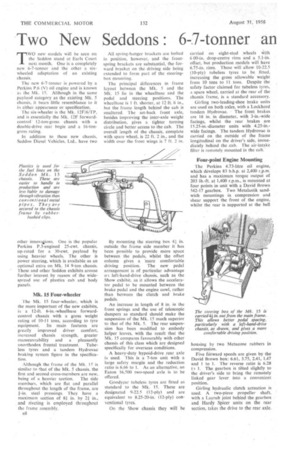Two New Seddons : 6-7-tonner an
Page 42

If you've noticed an error in this article please click here to report it so we can fix it.
Two new models will be seen on the Seddon stand at Earls Court next month. One is a completely new 6-7-tonner and the other a sixwheeled adaptation of an existing chassis.
The new 6-7-tonner is powered by a Perkins P.6 (V) oil engine and is known as the Mk. 15. Although in the same payload category as the existing Mk. 5 chassis, it bears little resemblance to it in either appearance or specification.
The six-wheeler is the Mk. 12F/6/TP, and is essentially the Mk. 12F forwardcontrol " 12-ton-gross chassis with a double-drive rear bogie and a 16-tongross rating.
In addition to these new chassis, Seddon Diesel Vehicles, Ltd., have two
other innovaitions. One is the popular Perkins P.3-engined 25-cwt. chassis, up-rated for a 30-cwt. payload by using heavier wheels. The other is power steering, which is available as an optional extra on Mk. 14 9-ton chassis.
These and other Seddon exhibits arouse further interest by reason of the widespread use of plastics cab and body panels.
ML 15 Four-wheeler
The Mk. 15 four-wheeler, which is the more important of the new exhibits, is a 12-ft. 6-in.-wheelbase forwardcontrol chassis with a gross weight rating of 10-11 tons, according to tyre equipment. Its main features are greatly improved driver comfort, increased chassis strength, greater manceuvrability and a pleasantly unorthodox frontal treatment. Tubeless tyres and a tandem Hydrovac braking system figure in the specification.
Although the frame of the Mk. 15 is similarto that of the Mk. 5 chassis, the first and second cross-members are new, being of a heavier section. The side members, which are flat and parallel throughout the length of the frame, are 1-in, steel pressings. They have a maximum section of 8* in. by 21 in., and riveting is employed throughout the frame assembly. All spring-hanger brackets are bolted in position, however, and the frontspring brackets are substantial, the forward bracket on the driving side being extended to form part of the steeringbox mounting, The principal differences in frame layout between the Mk. 5 and the Mk. 15 lie in the wheelbase and the pedal and steering positions. The wheelbase is 1 ft. shorter, at 12 ft. 6 in., but the frame length behind the cab is unaltered. The set-back front axle, besides improving the inter-axle weight distribution, gives a tighter turning circle and better access to the cab. The overall length of the chassis, complete with spare wheel, is 22 ft. 2 in., and the width over the front wings is 7 ft. 2 in.
By mounting the steering box 41 in. outside the frame side member it has been possible to provide more space between the pedals, whilst the offset column gives a more comfortable driving position. The new pedal arrangement is of particular advantage o.1 left-hand-drive chassis, such as the Show exhibit, as it allows the accelerator pedal to be mounted between the brake pedal and the engine cowl, rather than between the clutch and brake pedals.
An increase in length of 8 in. in the front springs and the use of telescopic dampers as standard should make the suspension of the Mk. 15 much superior to that of the Mk. 5. The rear suspension has been modified to embody helper leaves, with the result that the Mk. 15 compares favourably with other chassis of this class which are designed specifically for overseas conditions.
A heavy-duty hypoid-drive rear axle is used. This is a 7-ton unit with a large safety margin and the reduction ratio is 6.66 to L As an alternative. an Eaton 16,500 two-speed axle is to be offered.
Goodyear tubeless tyres are fitted as standard to the Mk. 15. These are designated 9-22.5 (12-ply) and are equivalent to 8.25-20-in. (12-ply) conventional tyres.
On the Show chassis they will be
carried on eight-stud .wheels With 600-in, drop-centre rims and a 5.1-in. offset, but production models will have 6.75-in. rims. These will allow 10-22.5 (10-ply) tubeless tyres to be fitted, increasing the gross allowable weight from 10 tons to 11 tons. Despite the safety factor claimed for tubeless tyres, a spare wheel, carried at the rear of the chassis frame, is a standard accessory.
Girling two-leading-shoe brake units are used on both axles, with a Lockheed tandem Hydrovac. The front brakes are 16 in. in diameter, with 3-in.-wide facings, whilst the rear brakes are 15.25-in.-diameter units with 4.25-in.wide facings. The tandem Hydrovac is carried on the outside of the frame longitudinal on the driver's side, immediately behind the cab. The air-intake filter is remotely mounted in the cab.
Four-point Engine Mounting
The Perkins 4.73-litre oil engine, which develops 83 b.h.p, at 2,400 r.p.m. and has a maximum torque output of 203 lb.-ft. at 1,400 r.p.m., is mounted at four points in unit with a David Brown 542-17 gearbox. Two Metalastik sandwich mountings in compression and shear support the front of the engine, whilst the rear is supported at the bell
housing by two Metacone rubbers in compression.
Five forward speeds are given by the David Brown box: 6.61, 3.75, 2.41, 1.47 and 1 to 1. The reverse ratio is 6.28 ti 1. The gearbox is tilted slightly to the driver's side to bring the remotely linked gear lever into a convenient position.
Girling hydraulic clutch actuation is used. A two-piece propeller shaft, with a Layrub joint behind the gearbox and Hardy Spicer units on the rear section, takes the drive to the rear axle.




































































































